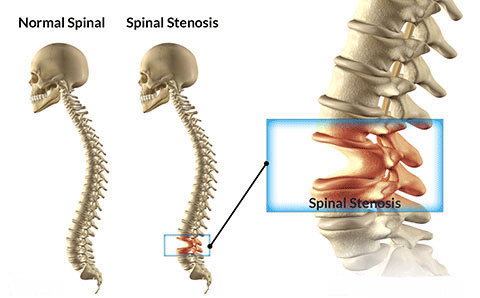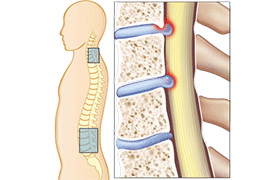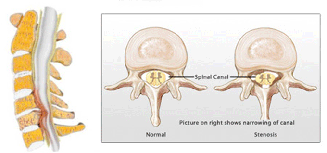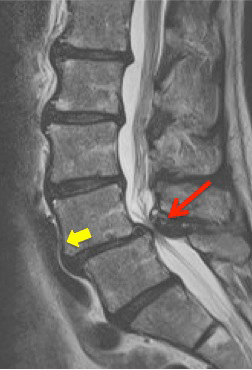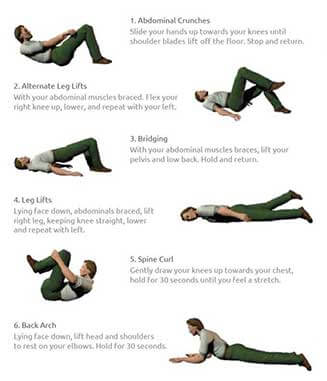Spinal Stenosis
Spinal stenosis is the narrowing of spaces in the spine (backbone) which causes pressure on the spinal cord and nerves.
Overall, spinal stenosis symptoms are often characterized as:
- Developing slowly over time, or slow onset;
- Coming and going, as opposed to continuous back pain;
- Occurring during certain activities (such as walking for lumbar stenosis, or biking while holding the head upright) and/or positions (such as standing upright for lumbar stenosis);
- Feeling relieved by rest (sitting or lying down) and/or any flexed forward position;
- Leg pain with walking is medically known as claudication, and it can be caused by either arterial circulatory insufficiency (vascular claudication) or from spinal stenosis (neurogenic or pseudo-claudication). Leg pain from either condition will go away with rest, but with spinal stenosis the patient usually has to sit down for a few minutes to ease the leg and often low back pain, whereas leg pain from vascular claudication will go away if the patient simply stops walking.
Symptoms of lumbar spine stenosis usually include leg pain (sciatica), numbness, tingling and/or burning. In severe cases, there may also be leg weakness. Low back pain may also be present, however the leg pain is usually more severe.
Tyes of Spinal Stenosis
Lumbar Spinal Stenosis
In lumbar stenosis, the spinal nerve roots in the lower back become compressed and this can produce symptoms of sciatica—tingling, weakness or numbness that radiates from the low back and into the buttocks and legs—especially with activity. For lumbar stenosis, flexing forward or sitting will open up the spinal canal by stretching the ligamentum flavum and will relieve the leg pain and other symptoms, but the symptoms will recur if the patient gets back into an upright posture. Numbness and tingling can accompany the pain, but true weakness is a rare symptom of spinal stenosis.
Cervical Stenosis
Spinal stenosis pain in the neck is called cervical spinal stenosis. This condition means that there is potential compression of the spinal cord. Unfortunately, the spinal cord compression can lead to serious problems such as extreme weakness, or even paralysis. With cervical stenosis, anyone who develops signs of spinal cord compression (myelopathy) may need more invasive treatment, such as surgery.
Thoracic stenosis can also occur, but is less common. The thoracic part of the spine is the middle/upper portion of the spine, and mainly consists of the vertebrae that are attached to the rib cage. This stable and strong part of the spine allows for minimal movement, which is why degenerative conditions such as spinal stenosis are less likely to develop.
Cervical stenosis symptoms with myelopathy
People with cervical stenosis with myelopathy may note one or more of the following spinal stenosis symptoms:
- Heavy feeling in the legs
- Inability to walk at a brisk pace
- Deterioration in fine motor skills (such as handwriting or buttoning a shirt)
- Intermittent shooting pains into the arms and legs (like an electrical shock), especially when bending their head forward (known as Lermitte’s phenomenon)
- Arm pain (cervical radiculopathy).
Diagnosis of Spinal Stenosis
MRI scan and/or a CT with myelogram can show the tight canal and spinal cord pinching associated with myelopathy from stenosis of the cervical spine.
Treatment
A suitable program of physical therapy and exercise is a component of almost every spinal stenosis treatment program. While the spinal stenosis exercises are not a cure, it is important for patients to remain active as tolerated and not become additionally debilitated from inactivity.
Activity modification
Patients are usually counseled to avoid activities that worsen their spinal stenosis symptoms. For lumbar stenosis, patients are typically more comfortable while flexed forward. For example, recommended activity modification might include walking while bent over and leaning on a walker or shopping cart instead of walking upright; stationary biking (leaning forward on the handlebars) instead of walking for exercise; sitting in a recliner instead of on a straight-back chair.
The Importance of Exercising
Before examining different exercises that may help with spinal stenosis, here are 5 important reasons to stay active:
- Exercise will increase the blood flow to the back, bringing needed oxygen and nutrients and washing away toxic metabolites.
- Exercise will strengthen the muscles around the spine, helping to take the pressure off of the bones and other static structures in the back.
- Exercise will help maintain flexibility, which will help prevent tight muscles that pull and torque the spine, which can worsen symptoms of spinal stenosis.
- Exercise will help maintain a healthy weight. Excess weight can lead to worsening back pain and leg pain.
- Staying active helps with emotional and mental health as well. Getting up and moving gets the blood and endorphins flowing and improves one’s overall outlook, which in turn helps reduce pain and improve physical symptoms.
Examples of Effective Exercises for Spinal Stenosis
An effective exercise program for people with lumbar spinal stenosis usually includes a combination of range of motion, strengthening, endurance, and stability related activities. Patients often find that activities/exercises for lumbar stenosis that are done in a bending – forward position are more comfortable.
- Some people find bicycle riding an enjoyable and rewarding activity. Stationary biking may be preferable.
- Others find swimming to be a positive activity, or water therapy (which is exercise in a pool).
- Joining a gym and working with a therapist or trainer is often an effective way to learn some good stretching and core strengthening exercises.
- Taking a Tai Chi class that involves slow, deliberate and flowing movements of the body is another way to exercise and treat spinal stenosis.
The above activities are on the smooth and repetitive end of the exercise spectrum. Patients may have less pain by avoiding the higher impact exercise such as jogging, avoiding contact sports, and avoiding long periods of standing or walking.
Other Conservative Treatments
Spinal stenosis is generally not progressive. The pain tends to come and go, but it usually does not progress with time. If the patient has a radiculopathy (myeloradiculopathy), conservative treatment like NSAIDS, activity modification and exercises for cervical stenosis may help relieve the arm pain. Conservative treatment for Spinal Stenosis include: Epidural injections and Medication Management with NSAIDS, Antidepressants, muscle relaxants, opioids for short term severe pain.
Surgery
10-15% of patients will require a laminectomy for spinal stenosis treatment. The only effective cervical stenosis treatment for myelopathy is surgical decompression of the spinal canal. If there is progressive weakness in the legs, then spinal stenosis surgery should be considered on an urgent basis rather than delayed in order to reduce the chance of long term nerve damage.
- While decompressive surgery (lumbar laminectomy) for spinal stenosis generally has a good success rate for relief of leg pain and leg symptoms (such as ability to walk), it is less reliable as a treatment for activity-related lower back pain.
- You may be a candidate for a less-invasive procedure (for example, insertion of an interspinous process spacer, such as an X-STOP spacer) that can relieve symptoms without the need for a laminectomy. Not everyone with spinal stenosis is a candidate for this type of surgery.
- Because spinal stenosis is caused by degenerative changes in the spine, symptoms may recur a few years after surgery for lumbar stenosis.

